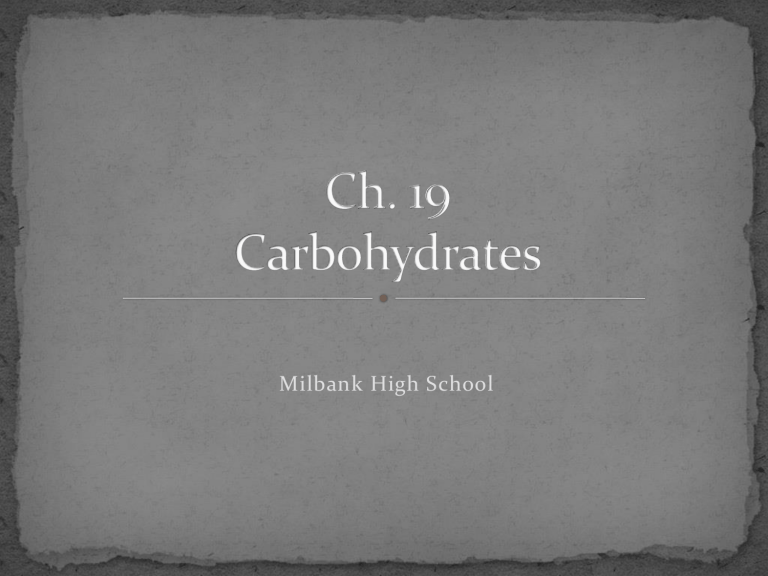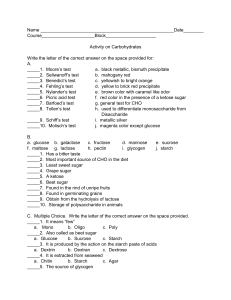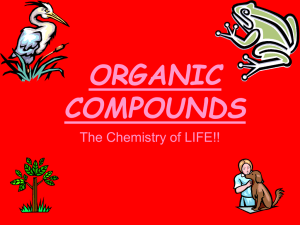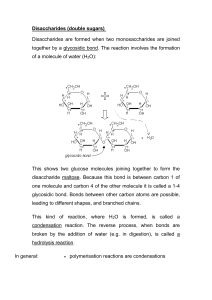
Milbank High School 1.What are carbohydrates? What is the difference between mono-, di-, and polysaccharides? 2.What are the structures of the most commonly occurring monosaccharides? Be able to classify them as aldoses or ketoses and as trioses, pentoses, or hexoses. 3.What is the difference between a D and an L sugar? 4.What is mutarotation? How does it occur? 5.What are the structures of sucrose, lactose, and maltose, the most common disaccharides? What monosaccharides make up each of these disaccharides? 6.Compare and contrast starch, glycogen, and cellulose. the chemistry of molecules and reactions found in living organisms “Carbon hydrates” Compounds containing carbon, hydrogen, and oxygen Starches and fibers (complex carbohydrates) Sugars Cellulose Contain hydroxyl groups And either an aldehyde or ketone Known as polyhydroxy aldehydes or ketones Simple carbohydrates Cannot be further hydrolyzed Contain 3-7 carbons Readily dissolve in water Can link together to form more complex carbohydrates Disaccharides Trisaccharides Polysaccharides Named using IUPAC to name monosaccarides Name the number of carbons, then add Trios, tetrose, pentose, hexose etc If aldehyde is attached: aldotetrose If ketone is attached: ketotetrose -ose Glucose Fructose Molecules that are nonsuperimposable mirror images of each other Have identical physical properties except one: They rotate plane-polarized light in opposite directions Simplest sugars Two enantiomers sugars L sugars D Aldohexoses 16 isomers (8 enantiomeric pairs) 3 most common: Glucose, mannose, galactose Ketohexoses 8 isomers fructose Most abundant sugar in nature Fruits “grape sugar” “Dextrose” b/c it is dextrorotatory Carbs converted to glucose Produces energy for our cells Circulating carbohydrate Blood sugar Synthetically made by the hydrolysis of starch Corn starch “corn sugar” Component of polysaccharide mannan Berries Vegetable ivory “endosperm” Differs from glucose at only one point Needed by human body for synthesis of lactose In mammary glands Also important constituent of the glycolipids Occur in brain in myelin sheath of nerve cells “brain sugar” Differs from glucose at only one point Only naturally occurring ketohexose Also similar structure to that of glucose Found in honey (40%) Formed in prostate gland Energy source for spermatozoa High-intensity sweeteners Manufactured in place of mono- and disaccharides Saccharin 1890’s 500-700 times sweeter than sucrose Carcinogenic Aspartame 1967 160 times sweeter than sucrose Used in diet soda Sucralose 1998 600 times sweeter than sucrose Passes through body unchanged Crystalline solids at room temperature Quite soluble in water Converted to anions when Tollen’s and Benedict’s reagents are used Used in simple and rapid diagnostic tests for the presence of glucose in blood or urine Composed of two monosaccharide units Joined when one monosaccharide reacts with the hydroxyl group of a second monosaccharide Forms a carbon-oxygen-carbon linkage “glycosidic linkage” Occurs in sprouting grain Forms “malt” in the manufacture of beer “malt sugar” About 30% as sweet as sucrose Body can’t utilize it directly Must be broken down by enzymes “Milk sugar” Occurs in the milk of humans, cows, and other mammals Human milk: 7.5% lactose Cow’s milk: 4.5% lactose Synthesized only by mammary tissue in nature Commercial produced from whey (from cheese) 1/6th as sweet as sucrose People are unable to digest lactose in milk Need lactase in small intestine to digest it properly Up to 20% of US population suffer some degree of lactose intolerance Produces bacteria in colon if not broken down properly Leads to abdominal distension, cramps, diarrhea Foods can be treated with lactase Lactacid® Tablets taken orally with dairy foods to assist in their digestion “Beet sugar, cane sugar, table sugar, or just sugar” Largest selling pure organic compound in the world Obtained from sugar canes and beets Average American: 100 pounds of sucrose every year May cause cancer, heart disease, migraine headaches, hyperactivity in children, obesity, and tooth decay Most abundant carbs in nature Store energy and make up plant cells High-molar mass Starch, glycogen, and cellulose Most important source of carbs in the human diet More than 50% of our carb intake Granule form Storage Potatoes: 15% Wheat: 55% Corn: 65% Rice: 75% Mixture of amylose and amylopectin Amylose: 60-300 glucose units per chain Amylopectin: 300-6000 glucose units Commercial starch White powder Stamps, envelopes, labels (sticky upon wetting) “animal starch” Reserve carb of animals All mammalian cells contain glycogen Liver and skeletal cells the most Used when fasting Fibrous carb found in all plants Cell walls Most abundant of all carbs Makes up 50% of all carbon in the vegetable world Much hydrogen bonding…insoluble in water Can’t be digested by humans Herbivores contain special enzymes to digest it and use it for energy Termites Insoluble fiber (cellulose) Reduces risk of colon cancer and heart disease (reduces cholesterol) ADA recommends 20-35 g a day Most Americans get 14-15 g a day



